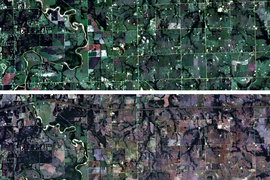Before Leila Mirzagholi arrived at MIT’s Department of Civil and Environmental Engineering (CEE) to begin her postdoc appointment, she had spent most of her time in academia building cosmological models to detect properties of gravitational waves in the cosmos.
But as a member of Assistant Professor César Terrer’s lab in CEE, Mirzagholi uses her physics and mathematical background to improve our understanding of the different factors that influence how much carbon land ecosystems can store under climate change.
“What was always important to me was thinking about how to solve a problem and putting all the pieces together and building something from scratch,” Mirzagholi says, adding this was one of the reasons that it was possible for her to switch fields — and what drives her today as a climate scientist.
Growing up in Iran, Mirzagholi knew she wanted to be a scientist from an early age. As a kid, she became captivated by physics, spending most of her free time in a local cultural center that hosted science events. “I remember in that center there was an observatory that held observational tours and it drew me into science,” says Mirzgholi. She also remembers a time when she was a kid watching the science fiction film “Contact” that introduces a female scientist character who finds evidence of extraterrestrial life and builds a spaceship to make first contact: “After that movie my mind was set on pursuing astrophysics.”
With the encouragement of her parents to develop a strong mathematical background before pursuing physics, she earned a bachelor’s degree in mathematics from Tehran University. Then she completed a one-year master class in mathematics at Utrecht University before completing her PhD in theoretical physics at Max Planck Institute for Astrophysics in Munich. There, Mirzgholi's thesis focused on developing cosmological models with a focus on phenomenological aspects like propagation of gravitational waves on the cosmic microwave background.
Midway through her PhD, Mirzgholi became discouraged with building models to explain the dynamics of the early universe because there is little new data. “It starts to get personal and becomes a game of: ‘Is it my model or your model?’” she explains. She grew frustrated not knowing when the models she'd built would ever be tested.
It was at this time that Mirzgholi started reading more about the topics of climate change and climate science. “I was really motivated by the problems and the nature of the problems, especially to make global terrestrial ecology more quantitative,” she says. She also liked the idea of contributing to a global problem that we are all facing. She started to think, “maybe I can do my part, I can work on research beneficial for society and the planet.”
She made the switch following her PhD and started as a postdoc in the Crowther Lab at ETH Zurich, working on understanding the effects of environmental changes on global vegetation activity. After a stint at ETH, where her colleagues collaborated on projects with the Terrer Lab, she relocated to Cambridge, Massachusetts, to join the lab and CEE.
Her latest article in Science, which was published in July and co-authored by researchers from ETH, shows how global warming affects the timing of autumn leaf senescence. “It’s important to understand the length of the growing season, and how much the forest or other biomes will have the capacity to take in carbon from the atmosphere.” Using remote sensing data, she was able to understand when the growing season will end under a warming climate. “We distinguish two dates — when autumn is onsetting and the leaves are starting to turn yellow, versus when the leaves are 50 percent yellow — to represent the progression of leaf senescence,” she says.
In the context of rising temperature, when the warming is happening plays a crucial role. If warming temperatures happen before the summer solstice, it triggers trees to begin their seasonal cycles faster, leading to reduced photosynthesis, ending in an earlier autumn. On the other hand, if the warming happens after the summer solstice, it delays the discoloration process, making autumn last longer. “For every degree Celsius of pre-solstice warming, the onset of leaf senescence advances by 1.9 days, while each degree Celsius of post-solstice warming delays the senescence process by 2.6 days,” she explains. Understanding the timing of autumn leaf senescence is essential in efforts to predict carbon storage capacity when modeling global carbon cycles.
Another problem she’s working on in the Terrer Lab is discovering how deforestation is changing our local climate. How much is it cooling or warming the temperature, and how is the hydrological cycle changing because of deforestation? Investigating these questions will give insight into how much we can depend on natural solutions for carbon uptake to help mitigate climate change. “Quantitatively, we want to put a number to the amount of carbon uptake from various natural solutions, as opposed to other solutions,” she says.
With year-and-a-half left in her postdoc appointment, Mirzagholi has begun considering her next career steps. She likes the idea of applying to climate scientist jobs in industry or national labs, as well as tenure track faculty positions. Whether she pursues a career in academia or industry, Mirzagholi aims to continue conducting fundamental climate science research. Her multidisciplinary background in physics, mathematics, and climate science has given her a multifaceted perspective, which she applies to every research problem.
“Looking back, I’m grateful for all my educational experiences from spending time in the cultural center as a kid, my background in physics, the support from colleagues at the Crowther lab at ETH who facilitated my transition from physics to ecology, and now working at MIT alongside Professor Terrer, because it’s shaped my career path and the researcher I am today.”










